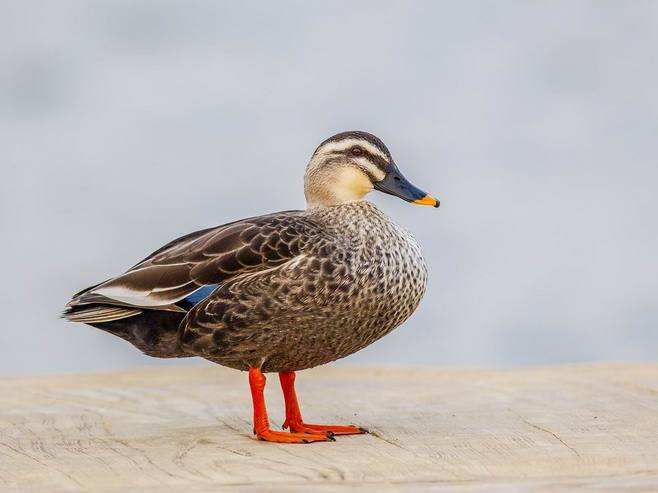Anas zonorhyncha
IUCN
LCBasic Information
Scientific classification
- name:Anas zonorhyncha
- Scientific Name:Spot-billed duck, Valley duck, Yellow-billed duck, Fire duck, Chinese spot-billed duck, Chinese spot-billed duck, Oriental spot-billed duck,Anas zonorhyncha,Eastern Spot-billed Duck,Chinese Spot-bille
- Outline:Waterfowl
- Family:Anseriformes Anatidae Anas
Vital signs
- length:498-638 mm
- Weight:890-1350 g
- lifetime:6-8 year
Feature
It is named after the characteristics of its mouth. Its mouth is black with a yellow tip. During the breeding season, there is a black spot on the tip of the yellow mouth, like a spot.
Distribution and Habitat
World distribution: Existing (resident birds): China (Hong Kong, Taiwan Island), Japan, the Democratic People's Republic of Korea and the Republic of Korea. Existing (breeding grounds): Mongolia and the Russian Federation (East Asia). (Non-breeding grounds): Bhutan.
Breeding in Northeast China, Inner Mongolia, North China, Northwest Gansu, Ningxia, Qinghai, all the way to Sichuan; wintering in the south of the Yangtze River in China, southern Tibet and Taiwan, some stay in the middle and lower reaches of the Yangtze River, East China and South China, and Taiwan all year round, as resident birds.
Mainly inhabits various inland lakes, reservoirs, rivers, ponds, estuaries, sandbanks and swamps, and also appears in coastal and farmland areas during migration and winter.
Appearance
The male Spot-billed Duck is brown from forehead to nape, with a brown-brown stripe from the base of the bill through the eye to the ear area; the eyebrow stripe is light yellow-white; the front of the eye, cheeks, neck sides, chin, and throat are all light yellow-white, and are dotted with dark brown spots. The upper back is gray-brown with brown, with brown-white feather edges, and the lower back is brown; the waist, upper tail coverts and tail feathers are black-brown, and the tail feather edges are lighter. The primary flight feathers are brown; the secondary flight feathers are blue-green with a purple luster, black at the proximal end, and white at the tip, forming a clear blue-green and purple-shiny wing mirror on the wing and the black and white edges on the rear edge of the wing mirror, which is very obvious when flying; the tertiary flight feathers are dark brown, and the outer vanes have a wide white edge, forming a clear white spot. The upper wing coverts are dark brown, wi
Details
Spot-billed duck is also called valley duck, yellow-billed duck, and fire duck. Spot-billed duck is one of the ancestors of Chinese domestic ducks, and its wild population is relatively abundant.

Spot-billed ducks build their nests in grass, bushes or bamboo bushes near waters. Grass stems, grass leaves, down feathers, etc. are the main materials for their nests.
They usually move in groups. They are very good at swimming, but most of the time they don't dive. The calls of the Spot-billed Duck during activities are very loud and crisp, and can be heard from far away.
Although the number of Spot-billed Ducks has been decreasing due to the large-scale hunting of Spot-billed Ducks by humans, the distribution range of Spot-billed Ducks is relatively wide, and the population is stable, so it has been rated as a species with no survival crisis.
Listed in the "Red List of Endangered Species of the World Conservation Union" (IUCN) 2018 ver 3.1-Least Concern (LC).
Listed in the "List of Terrestrial Wildlife with Important Economic and Scientific Research Value under State Protection" (Item 53) issued by the State Forestry Administration of China on August 1, 2000.
On September 30, 2020, the National Forestry and Grassland Administration issued the "Notice on Standardizing the Scope of Classification and Management of Prohibited Wildlife" on its official website. For 45 species of wild animals such as the spot-billed duck, the "Notice" clearly requires that relevant breeders should be actively guided to stop breeding activities before the end of December 2020 and complete the disposal work in accordance with relevant regulations. If it is necessary to retain a moderate amount of seed sources for non-edible purposes such as scientific research, the feasibility of the work plan should be fully demonstrated and the relevant procedures should be strictly followed.
Protecting the ecological environment and protecting wild animals is everyone's responsibility!








